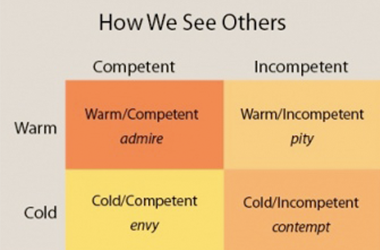Tips for Mothers for Busting Subconscious Stereotypes

 In a recent post, How Stereotypes About Warmth and Competence Impact Mothers , I talked about the Harvard Magazine profile of social psychologist Amy Cuddy, The Psyche of the Automatic, which highlights decades of research on automatic stereotypes and their impact on many different groups. I promised at the end to share some tips for women and mothers in particular to combat these unconscious stereotypes that seem to leave us in a no win situation.
In a recent post, How Stereotypes About Warmth and Competence Impact Mothers , I talked about the Harvard Magazine profile of social psychologist Amy Cuddy, The Psyche of the Automatic, which highlights decades of research on automatic stereotypes and their impact on many different groups. I promised at the end to share some tips for women and mothers in particular to combat these unconscious stereotypes that seem to leave us in a no win situation.
I best make good on my promise because the other day on the Fast Company blog the post Why Women Should Flirt at Work by Alicia Morga summarized the results of yet another study, “Women at the Bargaining Table: Pitfalls and Prospects,” which showed that women are in a classic double bind: “women may be perceived as competent but unlikable or as likable but incompetent.”
As the blogger tells it,
“The researchers found that both men AND women negatively evaluate women who do not behave in stereotypically female ways.
The choices then are these–work within the stereotypes or be careful in situations to not activate gender stereotypes.”
So let me offer a third option, bust the stereotypes.
Tackling unconscious stereotypes is a whole different ballgame than tackling conscious ones. Two very different brain processes are at work. While you can tackle conscious stereotypes with reason, persuasive argument, and even confrontation and shame, those don’t work with subconscious stereotypes. Especially because people aren’t even aware of their subconscious stereotypes so if you say confront your boss about bias against mothers, he or she will get defensive because in their conscious minds they have no bias. They aren’t aware that like most, the problem lurks in their subconscious. These stereotypes are best busted with frequent and more subtle strategies.
(On a side note, this applies to race as well. Those who want to tackle racial prejudice would be well-served to employ strategies aimed at the subconscious since at this time in our country, the majority of people have shed conscious racial stereotypes – what remains are powerful subconscious ones that continue to shape behavior.)
Here are some more appropriate strategies for women that I’ve extrapolated from the reams of research on subconscious stereotypes.
- Remind people of women and mothers they admire. Ideally women or mothers people likely admire for both competence and warmth or likability. Examples might include, “Wow, did you know Sandra Day O’Connor raised three sons between law school and her judicial career? I just read that.”
- Present yourself as counter-stereotype, subtly and frequently. In interviews, on the job, in meetings, you have multiple opportunities to send signals verbally and non-verbally. Keep in mind that generally others assess your warmth factor first and it counts for more than competence. Plus, people will tend to put you in one category – warm OR competent – and then assume you must not have the other quality. (See Harvard article)
Employed mothers are already perceived as nicer and warmer then fathers, men or women in the workplace, but less competent. So you want to send signals that reinforce competence without tanking your warmth factor. Sometimes women get advice to just “act like a man” – shed any stereotypically female behavior. Nope, that will just get you perceived as cold and competent. What you’re going for is to bust through to be perceived as warm and competent.
Find ways to keep your accomplishments on the radar. You don’t have to send a memo or make big pronouncements, just get comfortable mentioning them. “I’m feeling pretty proud of what my team and I pulled off last week, can I tell you about it?”
Don’t apologize for your involvement with your family. Simply couple it with reinforcement of your competence. “I’m leaving for my son’s soccer practice, and I’ll have those reports on your desk by noon tomorrow as promised.”
Address the unstated assumptions yourself. In an interview for example, “Everything in my homelife supports me doing a great job here.” Or, “I’m willing to travel.”
You don’t have to be the one offering baked goods at every meeting to continue to demonstrate warmth. Cuddy points out that non-verbal cues are particularly powerful. “Appropriate self-disclosure, the use of humor, and natural smiles all signal warmth,” says Cuddy. “So do behaviors called ‘immediacy cues,’ like leaning toward someone, communicating on the same physical plane, and being closer physically, although the ideal distance varies greatly across cultures.”
- Have another positively perceived woman or mother around. Important meeting or event? Invite or plant yourself next to a woman who in your organization or that context is positively perceived – or simply one who is not negatively perceived. This is a great role for a mentor if you have one. Just being there makes a difference. Exposure to another member of the group (in this case women or mothers) tends to deactivate the negative stereotypes without anyone having to say a word.
- More women in leadership roles. If you have the ability in your organization to encourage more women in leadership roles, one of the real benefits to the organization is that exposure to more women in leadership roles will decrease the subconscious bias toward women and mothers across the organization.
Yes it’s a delicate balance. It might even feel like mind games. This is reality though. Most people no longer consciously stereotype women and mothers, it’s subconscious, and you can play that mind game if you know how.

P.S. On a related note, you might be interested in my post on how these stereotypes impact our marriages and in this article on how gender stereotypes impact financial decisions.



[…] The good news is there are ways to combat these stereotypes. Just read “Tips for Mothers for Busting Stereotypes!” […]